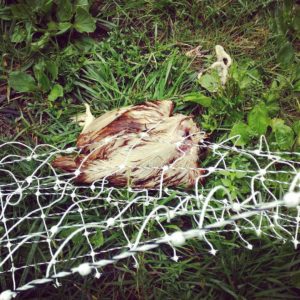
#farmlife #farm #chickens
Well, folks. We’re dealing with another smorgasboard of murder and gore on the homestead this week. We’ve had our share of having to task ourselves with chicken predator identification. On our homestead, specifically, we’ve identified:
- Foxes
- Raccoons
- Weasels
- Hawk
- Possum
Being in the mid-atlantic, this is to be expected. Oddly enough we’ve yet to deal with a snake predator, but that’s only inevitable.
The last couple of days have been hectic for us, as we’ve lost half of our ducks and several chickens (some of which were extra special) to a predator that has been able to get into two of our coops. We’ve attempted to sure up the coops as much as we can, and one of the coops we can’t even find the damn entrance they are using. But even last night, our one banty peep that was left is now gone. We are now in process of doing some chicken predator identification.
So we’ve taken a few measures.
-

Almost done! Should be completed today! @abundantpermaculture
#chickens #farmlife #farm #homesteading #chickencoopWe’ve done what we can to sure up our coops. Usually this involves installation of hardware cloth, which is hardy and small enough for no small predator to be able to get through. We also use A LOT of zip ties to help with larger holes in chicken wire (which I never recommend for chickens, ironically enough).
- We’ve spent the last several days and $500 building a Chickshaw for our main Americauna flock, using the design by Justin Rhodes of Abundant Permaculture. We’ve actually improved on the design in some aspects, and have ideas for improvement on future versions. But this is the design we loved best, and one that we feel is extremely sturdy, versatile, and safe for our flock.
- We’ve set out a trailcam every night, but have yet to catch the predator on it. I think our trailcam is getting old though, or isn’t being placed well. We’re going to keep trying though.
- We invested in some electrical portable fencing that will go around the chickshaw when it is ready (tonight).
- We’ve set a live trap with some sardines in it for bait, though it’s been out a week and has not caught anything (sigh).
- We also have a snap trap up on one of the coops that we think the predator is using to access. But, like the live trap, nothing has been caught.
So the frustration continues. Even when we finish the chickshaw and secure our Americauna flock, and maybe move our banty flock to a more secure location, we still have other flocks and a predator that we have yet to catch. So this will continue on until those things are no longer an issue.
Lessons we’ve learned to protect our chickens from predators:

#chickens #farmlife #farm #homesteading #chickshaw
- Never use chicken wire unless it’s for a run that chickens are not in overnight. Chickenwire is very useless at keeping chickens safe at night. Weasels can easily get through, raccoons can reach through, snakes can get through, and some predators can even chew through one of the wires to make a hole big enough. Instead, use hardware cloth (sometimes called “rabbit wire”) on all of your coop roosting areas for overnight protection.
- If you can, secure the edges of your coop with either concrete blocks or buried wire to prevent anything from digging under your coop walls
- Never stop being vigilant. The one day you get lazy may be the one day that raccoon decides to feast. It also helps to go over your coops every week or every other week to check for damage and potential access points
- Consider some companion animals for your flock. Geese and dogs are popular favorites for protecting a flock. They are protective animals and can deter pests from trying to get to your birds.
Methods for Chicken Predator Identification
Most chickens are attacked at night, so we’re mainly going to go over night predators. However, if you are experiencing a day predator, most likely you are dealing with a hawk or some form of bird predator. The only way to really protect against those is a type of roofing on the run that your chickens are in, or some form of visual bird detterent (pie plates, shiney decorations that wiggle in the wind, etc).
That said…night-time possibilities for chicken predator identification!
There are a couple ways to try and identify what type of predator is after your chickens. Generally we recommend investing in a trailcam so you can see what you are actually dealing with, but not everyone can do that right away, so you have to rely on some deduction of evidence.
Most predators have known habits in how they treat their prey that may help you identify your “varmant”. Here are some of the most known predators and their “method of kill”.
1. Raccoon
You can almost bet that 50% of your potential predator problems will be a raccoon (if you are in America). They are the #1 predator for chickens, probably because they are so common all over America. The main way to identify a raccoon attack is whether or not hte head is missing but the body is left behind. The body can also be mutilated somewhat but still usually a distance from the head. In our experience we’ve also seen raccoons totally mutilate the corpses of small pullets or peeps and scatter it all over the “kill zone”.
2. Weasel
Weasels are small little suckers, but they can be deadly and especially tempermental. They prefer to bite on the back of the neck of their prey and suck out the blood. You can usually tell a weasel attack by wounds on the back of a neck or head, and the guts have been removed.
3. Fox/Coyote/Dog
Foxes, Coyote’s and Dogs, while easier to prevent from getting into a coop because of their size, once they have access they can destroy a flock rather quickly. They will simply take your chicken whole and back to its den to feed its pups. If your chicken is simply missing, it could easily be one of these larger predators.
4. Possum
Possum’s are not as prevalent to attacking chickens as most on this list, but it’s still something to be on watch for. They have similar MO’s as the raccoon in that the head may be gone and the guts may be out. Their claws may be used to lacerate the chicken before eating it.
5. Skunk
If you find a bunch of empty eggshells, you may have a skunk. They enjoy a tasty egg and don’t swallow them whole like a snake would.
6. Owl
Owl’s usually have a precision head removal technique. If they don’t carry off the bird and just leave a clean-cut head, you could have an owl problem. It’s easier to tell if it’s an owl versus raccoon based on your containment setup, however. If you have roofing and a locked up area for roost, you won’t have to worry about owls.
How was your chicken dying?
- Head is missing – Raccoon orO
- Pile of feathers or just plain gone – Wolf, Coyote, Fox
- Body is left, but wound on the neck – Weasel
- Eggs are gone – Snake
- Eggs cracked open and empty – Skunk
Overall your best defense against predators is to be proactive rather than reactive. Secure your flock at night as best you can, keep an eye on them during the day.




